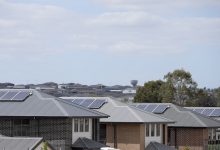The Australian Energy Market Commission has called on distribution networks to lead major and urgent reforms to accommodate – and capitalise on – the enormous amounts of rooftop solar being installed around the country, and the anticipated influx of battery storage and electric vehicles.
In a major report published on Thursday, the AEMC said electricity networks needed to evolve into trading platforms “where consumers are the drivers of change,” to avoid the need for significant new network investment.
The report says rooftop solar penetration has reached a point on the National Electricity Market where a “serious choices” need to be made: spend billions on new substations, poles and wires to cope, or start delivering the grid of the future.
Failure to act now, it says, would mean either fewer people were able to export their rooftop solar power to the grid, or all consumers would pay more to build new substations and poles and wires that would rarely be needed.
The move by the AEMC to recognise the grid of the future has been welcomed by the industry, although most suggest that the “urgency” is the result of its own failure to move on market changes that have been proposed for years.
Many also contest the fact that “billions” may be needed to be spent on substations, poles and wires, and point to the fact that voltage issues, one of the problems commonly blamed on rooftop solar, occur just as often at night-time and reflect other issues in the grid.
But analysts say the AEMC is moving forward. Mark Byrne, from the Total Environment Centre, says that just two years ago AEMC, like many in the industry, was focused only on the ‘cost” of rooftop solar and other distributed energy resources, and not on the many benefits.
“Now the AEMC has a much more holistic approach,” Byrne says.
“It is exploring ways of rewarding DER users for these benefits, while also enabling them to potentially be charged for exports in some places at some times where they impose costs on the network—and therefore on other consumers. This is an alternative to being constrained off or investing billions in new infrastructure to increase hosting capacity.”
The AEMC blueprint for the “grid of the future” comes as Australia heads for another record breaking year for small-scale solar installations, with the data from August charting an installation rate roughly 38 per cent ahead of the same time in 2018 – itself a record year.
The sustained boom has, indeed, caught most DNSPs off guard. The vast majority have been forced to place limits on the amount of rooftop solar households are allowed to export to the grid – or even restrict the size of rooftop solar installations, or ban them altogether.
And at a time when the wholesale shift to zero-carbon electricity is also an urgent task for Australia, to meet its global climate commitments and do its bit to prevent dangerous climate change, preventing consumers from investing in solar seems – at best – counter-intuitive.
“Consumers are already doing their part and investing in their own rooftop energy generation but distribution networks are not moving quickly enough to realise the value of those investments,” AEMC chief John Pierce said in comments on Thursday.
“A grid-enabled trading platform will open up a whole new world of opportunities for households and businesses – providing payments for services like frequency control and network support to make the power system stronger and enable higher levels of domestic demand response.
“But it’s not just nice to have,” Pierce added in an interview with ABC Radio’s Peter Ryan on Thursday morning – “if we don’t do this then the cost of the system will increase.
“[And we have a] sense of urgency, given the uptake of these resources … given that decisions that are made today about investment last for decades.
“We’ve got to get ahead of the game. Not making these reforms, and starting now is setting ourselves up for a repeat of the experience of driving large amounts of investment in hard infrastructure, which flows through to high prices.”
Pierce says the AEMC will do its part in driving this urgent reform by pushing ahead with proposals for new distribution network pricing, access and connection arrangements if proponents didn’t start that process themselves by early next year.
“We won’t stand by and allow the current situation to continue,” he said.
And while this will be welcome news to consumers, the solar industry and smart gird advocates, the networks are not entirely thrilled with being singled out as the speed-hump to progress by an organisation known for its own glacial pace on market reform.
Bit rich to be told “distribution networks are not moving quickly enough” by @the_AEMC – the body whose rulings ensured we are having a super-slow rollout of smart meters across most of the NEM https://t.co/HyVCG2pm9W
— Andrew Dillon (@AndrewDillon_EN) September 25, 2019
That said, the report – Integrating Distributed Energy Resources for the Grid of the Future – does not put all of the responsibility for reform onto the networks.
As part of what it calls a “sandbox of tools, it does want from networks is: improved visibility of loads and voltages on low voltage distribution networks (between homes and substations) so existing and future constraints can be identified and addressed; rule change requests to drive improvements in managing network operational information and system security supports, and; reform to network charging arrangements in light of the changing relationship between consumers and the power system.
To read the full story on RenewEconomy sister site One Step Off The Grid, click here…










